



Sequencing of the Chicken Genome: An Overview
By Hybro B.V. - Research papers published on 9 December 2004 in a special issue of the scientific journal Nature show that geneticists from around the world have assembled the entire chicken genome sequence. Following pioneering work on the human genome, inspired by health research and evolutionary studies, the chicken is the first agricultural animal in which this has been achieved.
Assembling the chicken genome opens new breeding opportunities
Additionally, the precise content and order of the chicken genome is almost complete. As this work progresses, the potential benefits for poultry breeders will increase further. Assembling the chicken
genome represents an important advance in agricultural genetics, opening the way
for faster and more accurate chicken breeding programmes at a time when demand
for chicken products is increasing strongly.
Nutreco Breeding Research and the Nutreco breeding company Euribrid have acted
as important initiators and facilitators in the chicken genome project. Nutreco first
approached the geneticists of Wageningen Agricultural University in the Netherlands
in 1989 with a proposal to support and collaborate in work on the chicken genome.
Wageningen has since become one of the leading research centres in the chicken
genome project. Wageningen and Nutreco Breeding Research have worked closely
on chicken genetics throughout the 15 years since then and the relationship
continues today.
To mark the historic milestone in the chicken genome project, Nutreco Breeding
Research organised a seminar on poultry genetics on 11 November at the EuroTier
fair in Hanover, Germany. The following articles provide a résumé of that seminar.
The seminar began with a welcome from Roald van Noort, Euribrid Managing
Director. He brought the significance of the chicken genome project into context, as a
threshold to a new, fast-moving chapter in poultry breeding, offering the potential for
highly specialised breeds that could be developed economically for small specific
markets. The chicken genome is the first in a series of genome mapping projects that
shortly will see similar achievements in cattle and pigs.
The Chicken Genome Sequencing Project
Martien Groenen, Professor of Molecular Genetics and Genomics, Wageningen
University, the Netherlands and co-author of all three papers in Nature 9 December
2004
The chicken genome is carried on 39 chromosomes and has over a billion base
pairs. Researchers used a “shotgun” approach to assemble information on the
genome. This can be likened to tearing the pages from several copies of a multi
volume encyclopaedia, cutting each page into a couple of hundred fragments then
comparing the fragments in an attempt to reassemble the encyclopaedia. As the
project progresses more volumes are reassembled, though some pages may still be
missing or in the wrong order.
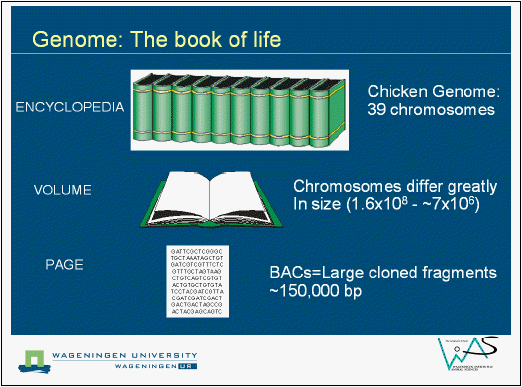
The assembled genome sequence provides a good basis for developing a large
number of markers that can be used in genetic studies. It also provides useful
information for comparison with other species, which in turn yields more knowledge.
For example, the turkey is genetically close to the chicken and therefore the chicken
genome project will contribute to progress in turkey breeding.
Approaching 90% of the estimated 20,000–23,000 genes have been identified so far.
Interestingly, more than expected have a role in immunity. Another intriguing aspect
is the extent of genetic variation between chicken breeds — around half of the
difference found between humans and chimpanzees. This suggests we have
significant potential for further developments in poultry breeding.

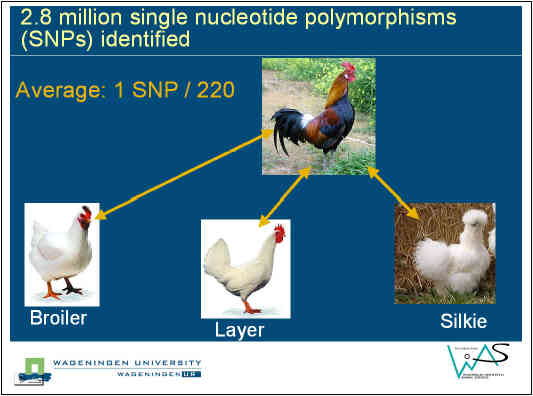
Another discovery from the project is that chickens and humans have a similar
number of genes for olfactory receptors, suggesting the chicken’s sense of smell is
much greater than previously thought.
Professor Groenen ended by acknowledging the other research centres in the
project. More than 50 centres, from Europe, the Americas and Asia, show the global
scale of this research.
How Can Genomic Information be Used in Breeding Programmes
William Muir, Professor of Genetics, Purdue University, Lafayette, Indiana, USA and
editor of the leading textbook “Poultry Genetics, Breeding and Biotechnology”
Classical breeding uses selection of characteristics identified in the phenotype. The
difficulty with this approach is that the phenotypic expression is a combination of
genetic potential with the effects of the environment in which the animal is born and
raised — it is nature combined with nurture. Influences from nurture include food,
disease and conflicts with other animals. A second source of difficulties is found with
characteristics, such as meat quality, that cannot be assessed in a live animal.
Together these problems make classical breeding a slow and costly process.
Knowing the genotype sequence takes us a significant step closer to being able to
select mainly on genetical information. The locations for genes for specific traits such
as egg number, body weight or carcass quality can be identified using markers and
then they can be selected directly. This technique is known as marker assisted
selection (MAS). As a result of the genome sequence project some three million
markers are now identified, opening the way for genome-wide MAS or GMAS.
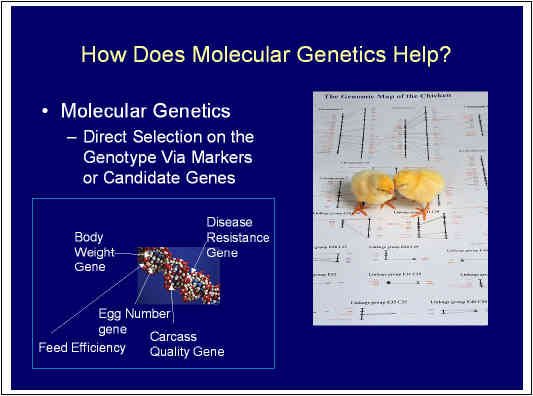
DNA is not influenced by the environment. Information on DNA can be retrieved from
birds of either sex at any age. Genes that relate to difficult-to-measure characteristics
such as disease resistance can be identified and selected.
However, it is probably not easy to detect all genes for all traits and the most
effective approach to breeding will be a combination of technologies. Selection
should combine GMAS with information on relatives and phenotypic expression.
Such an approach should significantly outperform the current best method using
BLUP (best linear unbiased prediction).
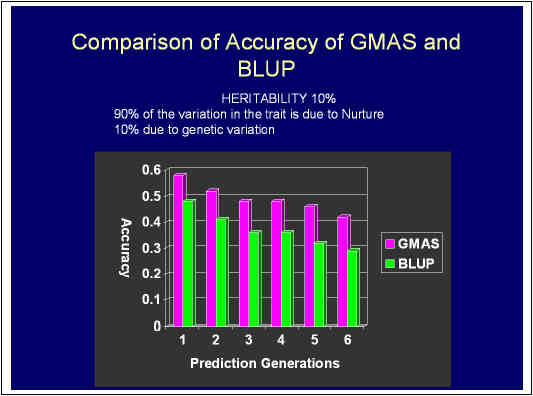
Genoculars — A Bio-informatics Tool for Genetics of Animal Species
Annemieke Rattink, Molecular Geneticist, Nutreco Breeding Research
Genoculars is a tool for searching automatically on the word wide web for information
held on all databases carrying data on genetics, including information relating to
identified traits in phenotypes. The results of each search are presented as a short
list of the genes that are most likely to have a direct influence on the characteristic
being researched. Genoculars was developed by Nutreco Breeding Research
together with Wageningen University and two other breeding companies.

Data gathered by Genoculars research is combined with phenotype and genetic
information held by Nutreco and Wageningen in private databases.

The Genoculars tool can be programmed to search for data, for example, on fat
metabolism. This can include data from other species such as humans and mice as
well as poultry. More specifically for poultry, searches have been run for traits such
as feather colour.

The effectiveness of Genoculars in chicken breeding should be substantially
increased following the completion of the chicken genome project. As specific
relevant genes are identified, the Nutreco/Wageningen team will develop DNA tests
to identify their presence, for example from blood samples, both speeding up and
simplifying the breeding process.

Genomics, Poultry Breeding and the Poultry Industry
Gerard Albers, Manager Nutreco Breeding Research
Nutreco Breeding Research is conducted at several Nutreco breeding centres in
Europe and North America. These centres have established a unique and long track
record of pioneering excellence in chicken, turkey and pig breeding.
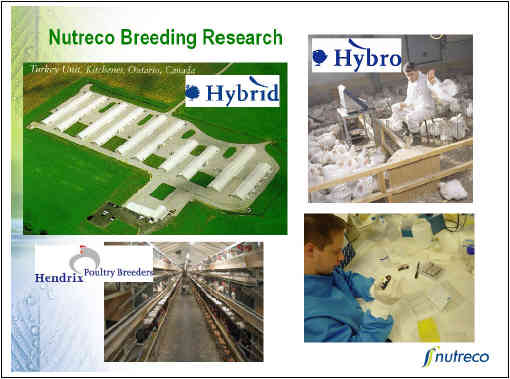
Poultry genome research in Nutreco, which began in the 1980s, has a number of
milestones including the development of chicken microsatellite markers in the early
90s, followed by turkey microsatellite markers in 1995–6, the identification of the
ascites gene in broilers around 2000 and the current achievements in bio-informatics
and gene identification in chicken and turkey.
The progress being made in genomics offers three valuable applications in breeding.
These are forensics for tracking and tracing, and DNA assays for single genes and
for total breeding value.
Though forensics in tracking and tracing is not fast enough to be used, for example,
in a product recall, it does provide an excellent means of validation, by identifying the
precise identity and origin of animal product samples.
DNA assays enable breeders to identify the presence of wanted and unwanted
genes. They can be used, for example, in selecting for resistance to avian leucosis
type A, which is based on a single gene mutation. The technology means optimum
grandparent and parent stock can be identified definitively. Nutreco Breeding
Research expects at least one new DNA test to become available every year from
now on.
The practical application of such knowledge and tests could have a significant impact
on the poultry industry, for instance by reducing the need to transport large numbers
of live birds around the world, as part of the breeding sequence. It would also enable
breeders working in regions that may have been closed, following disease outbreaks,
to continue with their breeding programmes, using blood samples sent abroad for
gene assays as a means of selection.
Advances such as GMAS open the way for tailor-made breeding (TMB), whereby
flocks can be developed for much more specific applications and environments than
is economically feasible at present. At the same time, these programmes would
require far less transporting of live birds — typically a breeding centre would take in a
new pure line once in five years rather than three times a year.
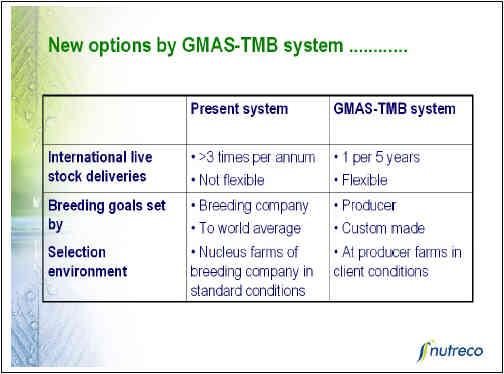
Assembling the chicken genome opens the doors to a new era in animal breeding.
Source: Hybro B.V. - March 2005








